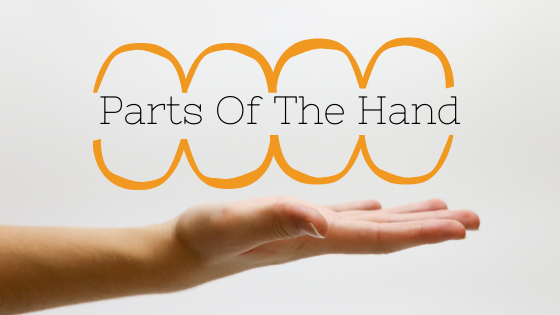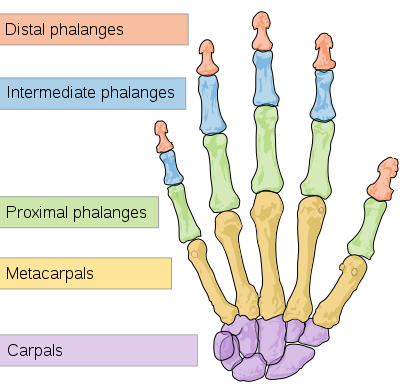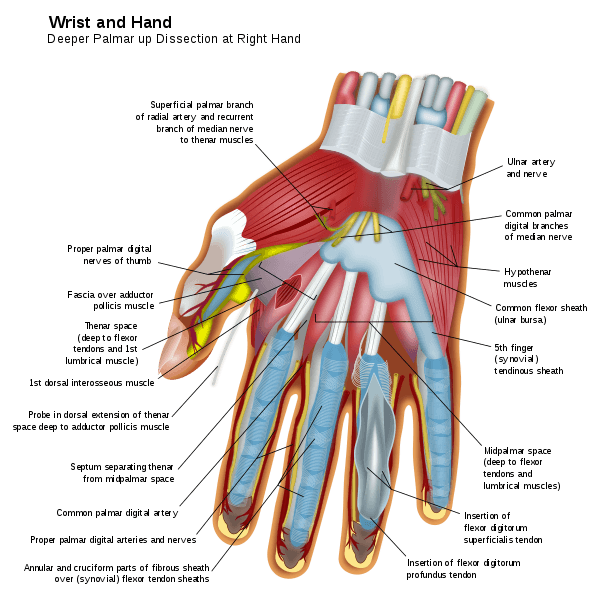
The parts of the human hand are capable of many different tasks, able to carry out a wide variety of functions. It can perform both fine and gross motor movements. You can pick up heavy objects and push things around, or you can do things like typing and writing with a pen.
The wide range of motion the human hands can make wouldn’t be possible without the various parts of the hand that compose it. The parts of the hand include the palm, fingers, back, and wrist of the hand.
“What the hand does the mind remembers.” — Maria Montessori
Defining Terms
Before we proceed any further, let’s take a moment to define our terms. Bones are collections of hard tissue that give shape and stability to the body. Finger bones are called phalanges, while the bones that make up the middle portion of the hand are referred to as the metacarpals. The carpals are the bones found in the wrist. There are also structures called volar plates within the bones of the hand, and these function to prevent the hand from bending backward and to stabilize the joints of the hand.
Joints are a region where two or more bones fit together, and these allow the bones in the hand to move. The hand also needs soft tissue to give support to the bones. Ligaments are soft tissue sections that stabilize joints and connect one bone to another bone. Finally, tendons are regions of soft tissue that join bone to muscle.
Now let’s go over the different segments of the hand.
Parts Of The Hand

Bones of the human hand. Photo: LadyofHats via Wikimedia Commons, Public Domain
The Fingers
The fingers of the hand are digits, or small distal portions of a limb. Humans and other animals use their fingers to both manipulate and sense the environment around them through touch. Some anatomists classify the thumb as a finger, while others don’t. This means that there are either four or five fingers depending on who is classifying them.
The bones of the fingers are known as the phalanges and there are proximal phalanges, intermediate phalanges, and distal phalanges. Beyond the bones found in the hand, there are also muscles and nerve fibers that run through the hands. There are also sesamoid bones within the hand, which are small chunks of bone or bone nodes found within the hand and their function is to reduce the pressure that is exerted on the nearby tissue. Each of the fingers can be flexed and relaxed by the muscles, and they can each move independently of one another. However, the muscles that move the fingers aren’t found within the fingers themselves, rather they are located in the forearm and in the palm.
“The five separate fingers are five separate units. Close them and the fist multiplies strength. This is organization.” — James Cash Penney
The skin of the fingers is highly sensitive, possessing the most touch receptors out of all areas of the skin, save for the genitals. The movement of the fingers is handled by the cerebral cortex, specifically the somatosensory cortex and regions of the primary and supplementary motor areas.
While other animals, like dogs and cats, have digits on their hands as well, these digits aren’t usually referred to as fingers because they can’t manipulate fine objects like humans and other primates can.
The Palm
The palm of the hand is what joins the various fingers together. The palm gives people a surface to hold things in, and the palm and the surrounding fingers create different arches. The arches found in the palm and fingers include transverse arches, longitudinal arches, and oblique arches.
The palm’s transverse arches are comprised of the carpal bones and the tips of the metacarpal bones, while the longitudinal arches are created by the bones of the fingers and the associated metacarpal bones that run the length of the hand. Finally, oblique arches are those that run between the four different fingers and the thumb.
When gripping an object, most of the work is done by the longitudinal arches between the thumb and the index finger and middle finger. These three fingers and palm work together to grip most objects, while the ring finger and the little finger typically just give reinforcements to the grip.
The Back Of The Hand And Nerves
The back of the hand is home to the dorsal venous network, a network of veins. The veins of the hand include radial, ulnar, and median nerves. The rear portion of the hand is also referred to as the dorsal opisthenar area.
There are two types of nerves in the hand, motor nerves and sensory nerves. In general, the motor nerves are responsible for innervating the extensors of the fingers and the abductor of the thumb. The median nerve of the hand is what supplies the wrist and digits with movement. Finally, the ulnar nerve is what controls the other muscles found in the hand.
The Wrist
The wrist has a few different definitions. The wrist can be defined as the radio-carpal joint or the wrist joint which is found between the carpals and the radius, the carpal bones (a collection of eight different bones that make up the proximal region of the hand’s bones), or as the entire anatomical region which envelops the carpus and includes portions of the meta-carpus.
The human wrist has a joint capable of pivoting, located between the different bones of the ulna, radius, and forearm. This joint is referred to as the distal radial ulnar joint. The carpal bones that can be said to make up the wrist include eight different bones, four each in the proximal and distal halves. The movement of the wrist joint allows the rest of the hand to move to different angles. The muscles of the hand that control the rest wrist actually located in the forearm, and when these are contracted the wrist moves.
Other Aspects Of The Hand
“Luck consists largely of hanging on by your fingernails until things start to go your way.” — Aaron Allston
The fingertips of the hand each have a fingernail. Fingernails are made out of a protein known as keratin, and proteins like keratin also create or hair. Keratin-based structures can also be found in the feathers/claws of birds and reptiles. The palm of the hand is one region of the body that doesn’t have melanin. Melanin is a skin pigment and the presence of melanin helps insulate people from the sun’s harmful ultraviolet rays. The palm of the hand doesn’t have hair follicles either. The soles of the feet are the only other regions of the body to lack both melanin and hair follicles.










